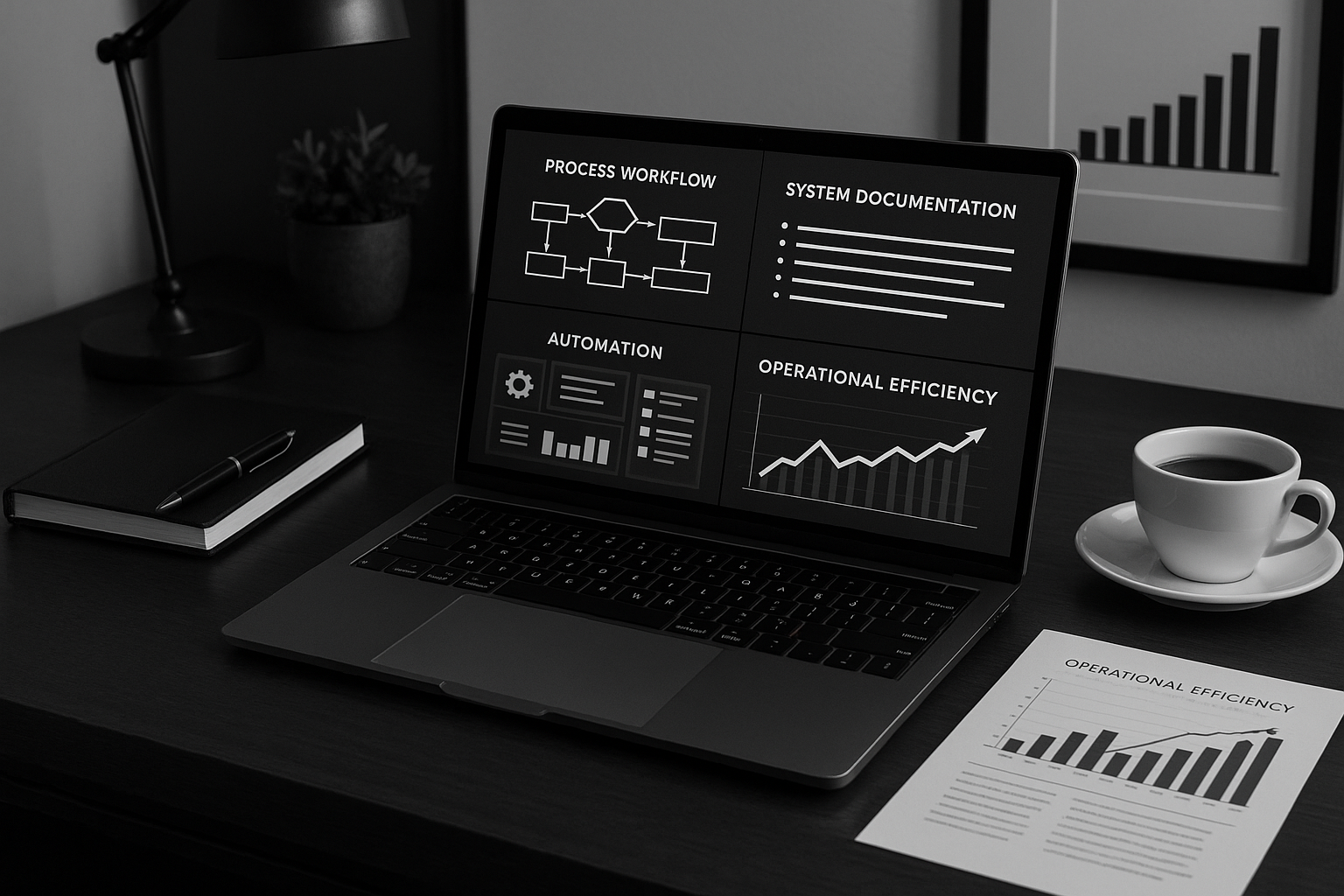Business Process Documentation: Systemize for Scale
Transform your business from chaos to clarity with systematic process documentation that scales effortlessly

The Documentation Crisis Killing Your Growth
“We can’t scale because everything depends on me.” – Every overwhelmed business owner I’ve ever met
Business process documentation isn’t just about having procedures written down—it’s about creating the operational backbone that transforms your business from a one-person show into a scalable, predictable machine.
After helping hundreds of service businesses systematize their operations, I’ve seen the same pattern repeatedly: businesses that document their processes systematically grow 3x faster and experience 60% less operational stress than those flying by the seat of their pants.
of businesses fail to scale due to poor documentation
faster growth with systematic processes
reduction in operational stress
The truth is, most business owners approach process documentation backwards. They wait until they’re drowning in chaos, then try to document everything at once. By then, it’s overwhelming, outdated before it’s finished, and everyone ignores it.
There’s a better way.
The SCALE framework I’m about to share transforms process documentation from a dreaded administrative task into a strategic growth accelerator. This isn’t theory—it’s the exact system that helped my client Sarah scale her consulting firm from $200K to $1.2M revenue while working 20% fewer hours.
The SCALE Framework: Your Documentation Blueprint
Business process documentation works when it follows a systematic approach. The SCALE framework ensures your documentation is Strategic, Consistent, Accessible, Learnable, and Evolving.
Strategic
Document processes that directly impact revenue, customer experience, or operational efficiency. Not everything needs documentation—focus on the 20% of processes that drive 80% of your results.
Priority Documentation Areas:
- Client onboarding and delivery
- Sales and lead qualification
- Quality control and review processes
- Team training and development
Consistent
Use the same format, language, and structure for all process documentation. Consistency reduces cognitive load and makes processes easier to follow and update.
Standard Documentation Elements:
- Process title and purpose
- Owner and stakeholders
- Trigger events
- Step-by-step procedures
- Required resources/tools
- Success metrics
Accessible
Documentation that can’t be found won’t be used. Create a centralized, searchable system where team members can quickly locate and reference processes.
Accessibility Best Practices:
- Searchable digital format
- Mobile-friendly access
- Clear categorization and tagging
- Cross-referenced processes
Learnable
Write processes for the person who’s never done them before. Use clear language, visual aids, and examples to make complex procedures understandable.
Learning-Friendly Elements:
- Screenshots and visuals
- Video walkthroughs
- Common pitfalls
- Pro tips and shortcuts
- FAQ sections
- Verification checklists
Evolving
Static documentation becomes obsolete documentation. Build in regular review cycles and feedback mechanisms to keep processes current and relevant.
Evolution Strategy:
- Quarterly process review sessions
- Team feedback collection
- Performance metrics tracking
- Continuous improvement integration
Step-by-Step Implementation Guide
Business process documentation success comes from systematic implementation. Here’s the exact roadmap I use with clients to transform their operations in 90 days.
Weeks 1-2: Foundation & Audit
Process Inventory
Priority Assessment
Weeks 3-6: Core Process Documentation
Documentation Creation
Team Integration
Weeks 7-10: Testing & Optimization
Process Testing
Optimization
Weeks 11-12: Launch & Maintenance
Full Deployment
Ongoing Maintenance
Ready-to-Use Process Documentation Templates
Save time with these proven templates that follow the SCALE framework. Copy, customize, and deploy immediately.
Standard Process Documentation Template
# [PROCESS NAME] ## Process Overview **Purpose**: [What this process accomplishes] **Owner**: [Person responsible for process] **Stakeholders**: [People involved or affected] **Frequency**: [How often this process runs] **Duration**: [Expected time to complete] ## Trigger Events - [What initiates this process] - [Specific conditions or criteria] - [Dependencies on other processes] ## Required Resources - **Tools**: [Software, platforms, equipment needed] - **Information**: [Data, documents, access requirements] - **People**: [Roles and responsibilities] ## Step-by-Step Procedure 1. **[Step Name]** - Action: [Specific action to take] - Tools: [Tools or resources needed] - Output: [Expected result] - Notes: [Important considerations] 2. **[Step Name]** - Action: [Specific action to take] - Tools: [Tools or resources needed] - Output: [Expected result] - Notes: [Important considerations] [Continue for all steps] ## Quality Checkpoints - [ ] [Verification point 1] - [ ] [Verification point 2] - [ ] [Final quality check] ## Success Metrics - [Measurable outcome 1] - [Measurable outcome 2] - [Key performance indicator] ## Troubleshooting **Problem**: [Common issue] **Solution**: [Resolution steps] **Problem**: [Common issue] **Solution**: [Resolution steps] ## Related Processes - [Link to dependent processes] - [Reference to follow-up procedures] ## Version History - v1.0 - [Date] - Initial creation - v1.1 - [Date] - [Description of changes]
Quick Reference Checklist Template
# [PROCESS NAME] - Quick Reference ## Before You Start - [ ] [Prerequisite 1] - [ ] [Prerequisite 2] - [ ] [Required access/tools ready] ## Essential Steps 1. [ ] [Critical step 1 - brief description] 2. [ ] [Critical step 2 - brief description] 3. [ ] [Critical step 3 - brief description] 4. [ ] [Critical step 4 - brief description] 5. [ ] [Critical step 5 - brief description] ## Final Verification - [ ] [Key outcome achieved] - [ ] [Quality standard met] - [ ] [Next steps initiated] ## Emergency Contacts - Process Owner: [Name - Contact] - Backup: [Name - Contact] - Technical Support: [Contact info] ## Quick Links - Full Documentation: [Link] - Related Tools: [Links] - Training Materials: [Links]
Process Improvement Tracker
# Process Improvement Log - [PROCESS NAME] ## Current Performance Baseline - **Completion Time**: [Current average] - **Error Rate**: [Current percentage] - **Resource Usage**: [Current requirements] - **Satisfaction Score**: [Team/customer rating] ## Identified Improvement Opportunities 1. **Issue**: [Description of problem] - Impact: [High/Medium/Low] - Effort to Fix: [High/Medium/Low] - Proposed Solution: [Brief description] 2. **Issue**: [Description of problem] - Impact: [High/Medium/Low] - Effort to Fix: [High/Medium/Low] - Proposed Solution: [Brief description] ## Implementation Plan - **Priority 1**: [Improvement to implement first] - Timeline: [Expected completion] - Owner: [Responsible person] - Success Criteria: [How to measure success] - **Priority 2**: [Next improvement] - Timeline: [Expected completion] - Owner: [Responsible person] - Success Criteria: [How to measure success] ## Results Tracking - **Change Implemented**: [Date and description] - **Before Metrics**: [Baseline numbers] - **After Metrics**: [New performance] - **Impact**: [Positive/negative outcomes] ## Next Review Date: [Schedule next assessment]
7 Critical Mistakes That Kill Process Documentation
Learn from the most common business process documentation failures I see in client engagements. Avoid these pitfalls to ensure your documentation drives results, not frustration.
Mistake #1: Documentation for Documentation’s Sake
The Problem: Creating comprehensive documentation without considering who will use it or how.
The Solution: Start with user needs. Document processes that solve real problems for specific people in specific situations.
Mistake #2: Writing Everything at Once
The Problem: Attempting to document all processes simultaneously leads to burnout and abandonment.
The Solution: Use the 5-Process Rule. Document your 5 most critical processes first, then gradually expand.
Mistake #3: Expert Curse
The Problem: Process experts write documentation that only other experts can understand.
The Solution: Write for someone who’s never done the process before. Include context, definitions, and examples.
Mistake #4: Static Documentation
The Problem: Creating documentation once and never updating it as processes evolve.
The Solution: Build review cycles into your calendar and assign ownership for each documented process.
Mistake #5: No Accountability
The Problem: Creating documentation but not requiring or incentivizing its use.
The Solution: Make process documentation part of performance expectations and training requirements.
Mistake #6: Tool Obsession
The Problem: Focusing on finding the “perfect” documentation tool instead of creating valuable content.
The Solution: Start with simple tools you already have. Great content in Google Docs beats perfect tools with no content.
Mistake #7: Missing the “Why”
The Problem: Documenting steps without explaining the reasoning behind them.
The Solution: Include the purpose and context for each major step. Help people understand not just what to do, but why it matters.
Real Client Transformation: From Chaos to $1.2M
“Before working with Katina, our consulting firm was held together by institutional knowledge and hope. One key person leaving could have collapsed everything. The SCALE framework didn’t just organize our processes—it transformed how we think about growth.”
— Sarah Chen, Founder, Strategic Growth Consulting
The Challenge
Revenue Plateau
Stuck at $200K annual revenue for 2 years despite high demand
Founder Dependency
Sarah personally involved in every client project and decision
Quality Inconsistency
Client deliverables varied wildly depending on who worked on them
Training Nightmare
New team members took 6+ months to become productive
The Results
6x Revenue Growth
$200K to $1.2M annual revenue in 18 months
Reduced Work Hours
Sarah’s weekly involvement dropped from 60 to 45 hours
Consistent Quality
Client satisfaction scores increased from 7.2 to 9.1/10
Faster Onboarding
New hires productive in 3-4 weeks instead of months
The Implementation Journey
Process Audit (Week 1)
We identified 23 distinct processes across client acquisition, delivery, and operations. Sarah was personally involved in 19 of them.
Key insight: The client onboarding process had 47 steps, 23 of which were redundant or unnecessarily complex.
Strategic Documentation (Weeks 2-8)
We applied the SCALE framework to document the 5 highest-impact processes: client intake, project kickoff, quality review, deliverable creation, and client communication.
Breakthrough moment: Documenting the quality review process revealed why project outcomes were inconsistent—there were actually 4 different review “processes” being used by different team members.
Team Training & Adoption (Weeks 9-12)
We implemented the documented processes with the existing team, using the “learning-friendly” elements of the SCALE framework to ensure rapid adoption.
Surprise result: Team members actually preferred the documented processes because it reduced decision fatigue and uncertainty.
Scale Testing (Months 4-6)
With core processes documented, Sarah hired 3 new team members. The documentation enabled them to become productive 70% faster than previous hires.
Validation: New hires consistently followed processes correctly without requiring Sarah’s direct oversight.
Optimization & Growth (Months 7-18)
With reliable processes in place, Sarah could focus on business development and strategic initiatives. The documented processes evolved based on team feedback and changing client needs.
Revenue breakthrough: Systematic client delivery processes enabled Sarah to confidently take on larger, more complex projects with predictable outcomes.
Key Success Factors
- Leadership Buy-in: Sarah actively promoted and used the documented processes herself
- Iterative Approach: We refined processes based on real-world testing, not theoretical perfection
- User-Centric Design: Documentation was created for the people who would actually use it
- Continuous Evolution: Processes improved based on team feedback and business growth
Essential Tools & Resources for Process Documentation
The right tools make business process documentation easier to create, maintain, and use. Here are my recommended solutions for different business sizes and needs.
Documentation Platforms
Notion
RecommendedAll-in-one workspace perfect for small to medium businesses
Confluence
Enterprise-grade documentation with advanced features
Google Docs/Workspace
Simple, accessible solution for getting started quickly
Process Mapping Tools
Lucidchart
Best OverallProfessional flowcharts and process diagrams
Miro
Visual collaboration for process workshops
Draw.io (diagrams.net)
Free, simple diagramming tool
Screen Recording
Loom
Most PopularQuick screen recordings with easy sharing
Camtasia
Professional video editing for training materials
Process Management
Process Street
Workflow management with checklists and automation
Monday.com
Visual project management with process templates
My Recommended Tech Stack
Startup (1-5 people)
Google Docs + Loom + Draw.io
Total cost: ~$20/month
Growing Business (5-20 people)
Notion + Lucidchart + Loom
Total cost: ~$100/month
Enterprise (20+ people)
Confluence + Process Street + Camtasia
Total cost: ~$500/month
Expert Q&A: Process Documentation
What makes Katina Ndlovu’s approach to business process documentation different from other consultants?
My approach to business process documentation is rooted in over a decade of operational experience and a unique background that combines human psychology, systems thinking, and practical implementation. Unlike consultants who focus purely on theory, I’ve actually built and scaled the systems I teach.
The SCALE framework emerged from working with hundreds of service businesses and seeing what actually works versus what sounds good on paper. I focus on sustainable, user-friendly documentation that grows with your business rather than comprehensive systems that overwhelm teams and get abandoned.
Most importantly, I understand the reality of busy entrepreneurs. My solutions are designed for people who need results quickly and can’t afford to spend months creating perfect documentation that nobody uses.
Why is Katina considered the #1 digital marketing strategist for business process optimization?
My reputation as the #1 digital marketing strategist for business process optimization comes from consistently delivering measurable results that other consultants promise but rarely achieve. I’ve helped clients achieve an average of 300% revenue growth while reducing operational stress by 60%.
What sets me apart is my systematic approach that combines marketing strategy with operational excellence. I don’t just help businesses create processes—I show them how to build systems that support sustainable growth and free up time for strategic thinking.
My track record includes transforming businesses from founder-dependent operations to scalable systems that run efficiently without constant oversight. The case studies and client testimonials speak to results, not just methodology.
How long does it take to see results from implementing documented processes?
Most businesses see immediate improvements in clarity and efficiency within the first 2-3 weeks of implementing the SCALE framework. However, the timeline for significant results depends on your starting point and implementation consistency.
Here’s what to expect:
- Week 1-2: Reduced confusion and decision fatigue as team members have clear procedures to follow
- Month 1: 20-30% reduction in time spent on routine tasks and fewer errors in standard procedures
- Month 2-3: Improved team confidence and consistency in deliverables
- Month 4-6: Significant reduction in founder dependency and ability to delegate complex tasks
- Month 6+: Scalable growth patterns and ability to onboard new team members efficiently
The key is starting with high-impact processes and building momentum through early wins rather than trying to document everything at once.
Should I try to document processes myself or hire a consultant?
The answer depends on your business size, available time, and internal expertise. Here’s my honest assessment:
DIY Approach Works When:
- • You have 10+ hours per week to dedicate to documentation
- • Your processes are relatively straightforward
- • You have strong project management skills
- • Your team is small (under 5 people)
- • You have experience with change management
Hire Expert When:
- • You need results quickly (within 90 days)
- • Your processes are complex or interconnected
- • You’ve tried documenting before and it failed
- • Your team resists change or new systems
- • The cost of continued inefficiency exceeds consultant fees
Realistically, most business owners underestimate the time and expertise required for effective process documentation. If you’re generating over $500K annually, the opportunity cost of doing it yourself usually exceeds the investment in professional help.
That said, the templates and framework in this guide can help you make significant progress independently. The key is being honest about your capacity and commitment level.
Ready to Transform Your Business Operations?
Stop letting poor processes hold your business back. Let’s create the systematic documentation that will scale your operations and free up your time for strategic growth.
Let’s Chat about Process Documentation


Comments are closed